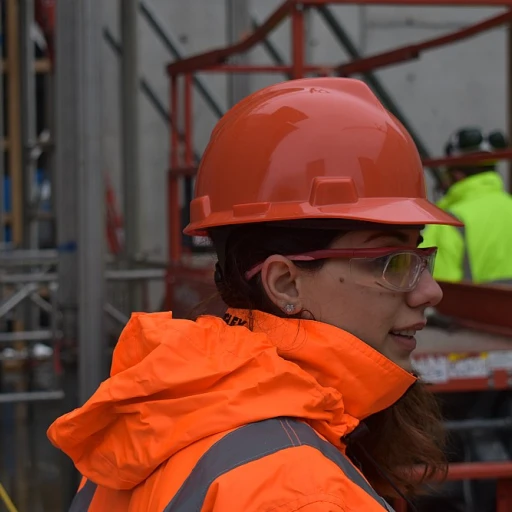
Understanding the Role of Senior Leaders in Feedback
Senior Leadership: A Catalyst for Effective Feedback
In the realm of employee engagement, senior leaders play a pivotal role. Their influence extends beyond mere decision making, permeating the entire organization’s culture and setting the tone for how feedback is perceived and implemented. The active involvement of senior leaders in feedback processes is essential for cultivating a workplace environment where employees feel heard and valued.
A commitment to leadership in feedback can significantly boost the company's growth and success. When senior executives actively participate, they emphasize the importance of feedback and serve as role models for other team members. This involvement creates an atmosphere of trust and encourages open communication throughout the organization.
However, engaging senior leaders comes with its own set of challenges, such as time constraints and effectively communicating the importance of strategic questions that align with business goals. It also involves navigating the intricate dynamics of leadership style and ensuring that feedback sessions contribute positively to professional development and career growth.
For organizations aiming for long-term success, integrating structured feedback processes led by senior leaders can help enhance the company culture significantly. It promotes a cohesive understanding of the mission and core values among employees, ultimately driving the company forward.
Embracing digital transformation in feedback mechanisms can further empower senior leaders, enabling them to gather insights efficiently and act decisively. By leveraging modern office technology, leaders can streamline feedback processes, ensuring that they remain timely, relevant, and impactful. To learn more about how technology can be utilized in feedback systems, you might consider exploring strategies for enhancing workplace dynamics with modern office technology.
Crafting Effective Questions for Senior Leaders
Fostering Effective Communication through Strategic Inquiry
Senior leaders play a pivotal role in shaping the culture and success of an organization. To engage them effectively, crafting questions that resonate with their leadership style and responsibilities is crucial. These questions should not only address immediate business challenges but should also touch upon long-term objectives and company culture. When designing questions for senior leaders, it is important to consider their strategic vision and decision-making process. Asking good questions can help uncover their priorities and how they align with the company’s overarching goals. For instance, questions that explore how the organization’s culture is evolving or how leaders envision the company adapting to digital transformation are valuable. Furthermore, it's critical to include inquiry that focuses on the professional development of team members and career growth opportunities within the organization. Strategic questions can bridge the gap between senior executives and other employees, fostering a culture of open dialogue and mutual respect. Here's a simple guide to keep in mind:- Career Alignment: "How do you ensure that the company's objectives align with individual career aspirations of team members?"
- Leadership Influence: "What leadership strategies do you find most effective in enhancing employee engagement within different teams?"
- Strategic Vision: "How does your vision for the company’s future influence current decision-making processes?"
The Impact of Feedback on Organizational Growth
The Influence of Constructive Feedback on Growth
Senior leaders play a pivotal role in shaping the trajectory of any organization. Constructive feedback from employees can drive positive change by illuminating pathways toward upscaling business processes and enhancing company culture. When feedback is effectively integrated into organizational strategy, multiple facets of the workplace can experience significant improvement.- Career and Professional Development: Constructive feedback provides valuable insights into the areas where senior executives can refine their leadership style, thereby supporting the career growth of their team members. Through strategic questions, insights garnered can aid in mapping out professional development plans that align with company goals and individual aspirations.
- Culture and Team Dynamics: The feedback loop encourages an open dialogue about company culture and employee engagement. It fosters an environment that values inclusivity and supports decision making, empowering employees at every level. This openness can help identify potential challenges early on, allowing the organization to tailor its approach for overcoming them.
- Operational Agility: Feedback can highlight areas where the organization, or specific teams, may benefit from adopting new technologies or refining current processes. For example, employing a modern approach like the 2-2-3 work schedule can enhance productivity and improve work-life balance by promoting a more efficient workflow.
Challenges in Communicating with Senior Leaders
Overcoming Barriers in Leadership Communication
Communicating effectively with senior leaders can be a daunting task for many employees. The challenges often stem from the hierarchical nature of organizations and the busy schedules of senior executives. Understanding these barriers is crucial for fostering a culture of open dialogue and feedback.
One of the primary challenges is the time constraint. Senior leaders often juggle numerous responsibilities, making it difficult for them to allocate time for feedback sessions. This can lead to a perception that feedback is not a priority, which can hinder employee engagement and morale.
Another significant challenge is the leadership style of senior executives. Some leaders may have a more autocratic approach, which can stifle open communication and discourage employees from voicing their opinions. In contrast, leaders who adopt a more inclusive style can create an environment where feedback is valued and encouraged.
The company culture also plays a vital role in how feedback is communicated. In organizations where feedback is not part of the regular business practice, employees may feel apprehensive about approaching senior leaders with their concerns or suggestions. This can lead to a lack of transparency and hinder the company's long-term success.
To address these challenges, it's essential to craft strategic questions that resonate with senior leaders and align with the organization's goals. This approach not only helps in breaking down communication barriers but also enhances the overall feedback process.
Moreover, fostering a culture of feedback requires a concerted effort from both leaders and team members. By prioritizing professional development and career growth, organizations can create an environment where feedback is seen as a tool for success rather than a critique.
Ultimately, overcoming these communication challenges involves a commitment to continuous improvement and a willingness to adapt to the evolving needs of the organization. By doing so, companies can ensure that feedback becomes an integral part of their business strategy, driving both employee and organizational growth.
Best Practices for Feedback Sessions with Senior Leaders
Effective Strategies for Conducting Feedback Sessions
Conducting feedback sessions with senior leaders in an organization requires a strategic approach. Understanding the nuances of these sessions can foster a productive dialogue that enhances company culture and contributes to business success. To optimize these sessions, consider the following strategies:- Prepare Thoroughly: Prior to the session, gather pertinent information about the leader's background, recent projects, and leadership style. This preparation will facilitate the formulation of good questions that target specific areas of leadership and decision making.
- Foster a Safe Environment: Create an atmosphere of trust to encourage openness. This involves respecting each leader's time and input, which can help break down barriers and make leaders more receptive to feedback.
- Focus on Professional Development: Highlight how the feedback can contribute to their own career growth and the organization's long-term goals. Discuss how leadership behaviors impact employee engagement and business outcomes.
- Utilize Open-Ended Questions: Encourage in-depth discussions with questions that invite reflection, such as, "How do you perceive your role in fostering a positive company culture?" or "What challenges have you faced in aligning team goals with the organization's strategic objectives?"
- Invite Follow-Up: After presenting initial feedback, ask follow-up questions to delve deeper into specific areas or concerns. This will help clarify any ambiguities and provide leaders with actionable insights.












